Conservation Laboratory
Head – Ms. Nina Koskanen
Established in 2011, the Zinman Institute of Archaeology’s conservation laboratory specializes in the conservation and restoration of archaeological finds. The laboratory was established and headed by Dr. Alexander Iermolin, a master conservator. Since 2022 the lab is headed by Nina Koskanen with Dr. Iermolin’s professional assistance.
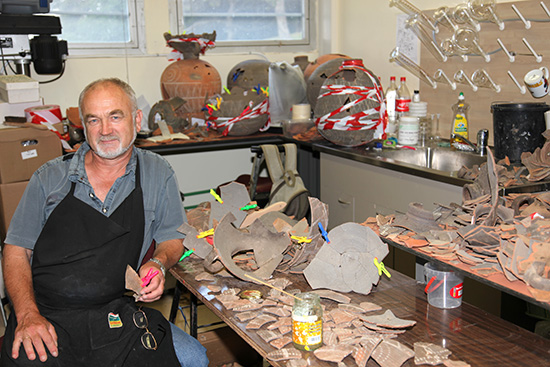
The laboratory provides services to archaeological delegations from Israel and abroad, as well as to museums, public and governmental institutions, individual researchers, and registered antiquities collectors.
The laboratory’s principal field of expertise is the conservation and restoration of metal artifacts, the preservation of which so often presents serious technical and professional challenges. In addition, the lab’s staff provides restoration services for pottery, glass, and other inorganic materials. 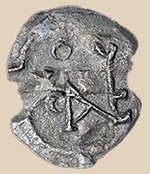 While we do provide services for preserving items made of worked animal bone, see below, generally speaking the laboratory does not specialize in the preservation of organic materials.
While we do provide services for preserving items made of worked animal bone, see below, generally speaking the laboratory does not specialize in the preservation of organic materials.
Conservation and Restoration of Metals
The specific method of conservation and restoration is individually tailored for each item. This begins with the selection of the most suitable technique for cleaning the artifact (whether mechanical, chemical, or a combination of the two), up to the stabilization and final fixing and of the process.
- Coins – A full-cycle process for the cleaning of coins of various metallic compositions including: an initial, microscopically supervised mechanical cleaning of the coin; when required, a controlled chemical cleaning (without electrolysis) of the specimen; completion of the cleaning process, once again conducted under microscopic supervision; and the final fixing of the process, following the extraction of all salts, by coating the coin.
- Bronze, silver, gold, and other metallic artifacts – Controlled mechanical and chemical cleaning of finds made of copper, bronze, silver, or gold, depending on the quality of the metal and the item’s current state of preservation.


 The famous mask of Pan from Hippos during conservation process
The famous mask of Pan from Hippos during conservation process - Iron artifacts – Inasmuch as an artifact made of iron is particularly prone to decay, it goes through several processes to determine the quality of the metal and how to best clean and preserve it. There are a number of methods for preserving iron. When required, the find must first be X-rayed before the restoration process is started. Then, the artifact is mechanically cleaned, dried in a special oven, chemically stabilized if necessary, and finally soaked in a polymer-based preservative.
Stucco, wall painting and worked bones 
For the cleaning and conservation of stucco, wall paintings and worked animal bone, treatment is mostly by means of mechanical cleaning, followed by stabilizing the conserved item using materials based on polymers.
Glass finds
Restoration involves the cleaning and, when necessary, stabilization of the item.
Ceramic restoration
Potsherds are cleaned mechanically and/or chemically depending on the extent and type of fouling. Gaps and form in restored pottery vessels are completed with plaster fillers.

When an artifact reaches the laboratory, it is initially photographed in its current state, and transferred to temporary storage depending on the type of the find. Metal objects are stored in a special, humidity-controlled desiccator cabinet (humidity=10%), while non-metallic finds are enclosed in sealed storage containers, also with humidity control. From start to finish, the entire conservation procedure is photographed and documented. At end of the process, a conservation report is issued.
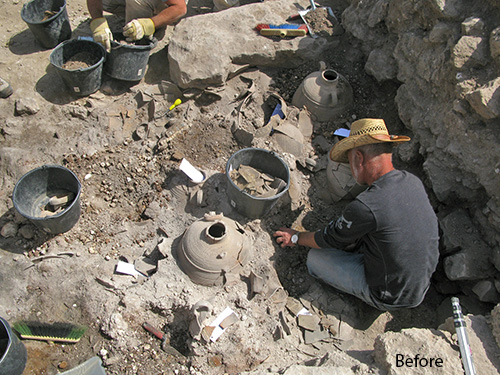
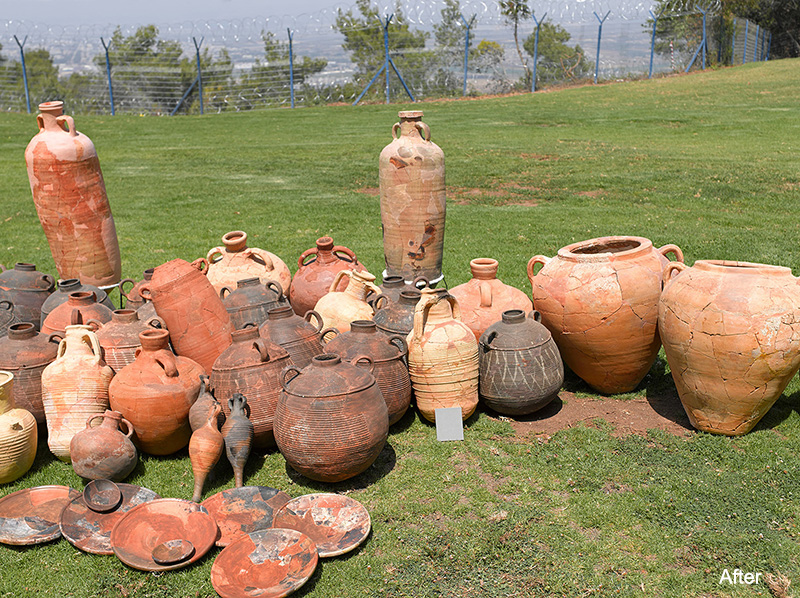
Past and recent projects
- Porphyreon/Shikmona Excavations Project – The Zinman Institute of Archaeology, University of Haifa
- Maresha Excavation – The Zinman Institute of Archaeology, University of Haifa
- Majduliyya Excavation – The Zinman Institute of Archaeology, University of Haifa
- Tel Dor Excavations Project – The Institute of Archaeology, The Hebrew University and The Zinman Institute of Archaeology,
University of Haifa - Hippos-Sussita Excavations Project – The Zinman Institute of Archaeology, University of Haifa
- Mi’ilya Excavations – The Zinman Institute of Archaeology, University of Haifa
- Omrit Excavation Project – Carthage College, USA
- Jaffa Excavations – The Institute of Archaeology, UCLA, USA
- Beit She’arim Excavations – The Zinman Institute of Archaeology, University of Haifa
- Nesher Ramle Excavations – The Zinman Institute of Archaeology, University of Haifa
- Monfort Fortress Excavations – The Zinman Institute of Archaeology, University of Haifa
- Abreca Excavations – The Zinman Institute of Archaeology, University of Haifa
- Tirat Carmel Excavations – The Zinman Institute of Archaeology, University of Haifa
- Magdala Excavation Project – Anahuac University, Mexico
- Shivta Excavation Project – The Zinman Institute of Archaeology, University of Haifa
- H’irbet al-Manhat – The Zinman Institute of Archaeology, University of Haifa
Maresha Excavation – The Zinman Institute of Archaeology, University of Haifa
Galilee Hiding Complexes – Prof. Yinon Shivtiel, Zefat Academic College
- Hecht Museum – University of Haifa
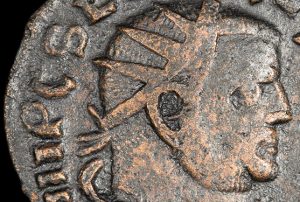
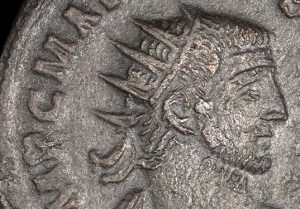
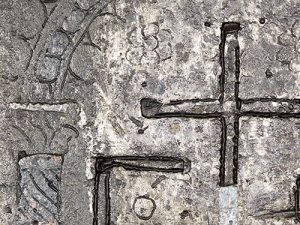
Our laboratory welcomes new projects from all over the world
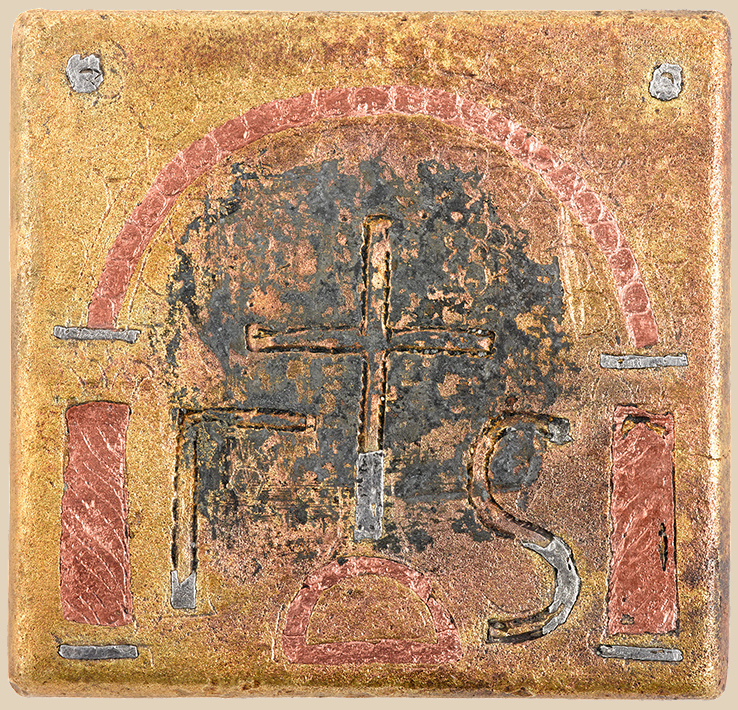
The lab will be happy to respond to any inquiries you may have.
Phone: 972-4-8249392
E-mail: arch@research.haifa.ac.il

